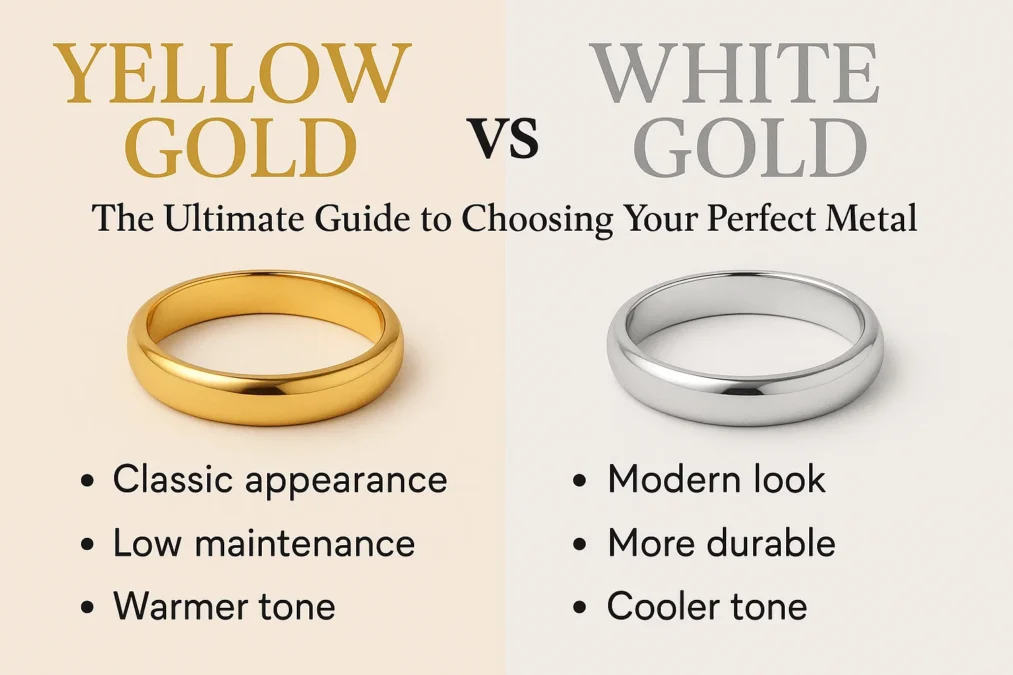Welcome to the timeless debate that has captivated jewelry lovers for generations: yellow gold vs white gold. If you’re shopping for an engagement ring, a special gift, or a treat for yourself, this choice is one of the most fundamental you’ll make. It’s more than just a color preference; it’s about style, skin tone, lifestyle, and even the science behind the shine. Both metals have a rich history and a passionate following, but they offer distinctly different aesthetics and practicalities.
This isn’t a decision to rush. Your jewelry is an extension of your personality and is often meant to last a lifetime. Do you gravitate towards the warm, classic glow of yellow gold, a metal that has been adored since ancient times? Or are you drawn to the sleek, modern brilliance of white gold, which offers a contemporary twist on luxury? This comprehensive guide will walk you through every detail, from the alloy composition and durability to maintenance and cost. We’ll strip away the confusion and provide you with the expert knowledge you need to feel confident in your choice between yellow gold and white gold. Let’s dive into the fascinating world of these two precious metals.
Understanding What Gold Actually Is
Before we can truly compare yellow gold and white gold, we need to understand what we’re working with. Pure gold, often called 24-karat gold, is a incredibly soft and malleable element. If you were to wear a ring made of pure 24k gold, it would quickly bend, scratch, and lose its shape. It’s beautiful, but utterly impractical for everyday jewelry that needs to withstand the rigors of daily life.
This is where alloys come into play. To make gold durable enough for rings, necklaces, and bracelets, it is mixed with other, stronger metals. The purity of gold is measured in karats, which indicate the ratio of pure gold to other metals in the alloy. For example, 18-karat gold is 18 parts pure gold and 6 parts other metals, making it 75% pure. Similarly, 14-karat gold is 14 parts pure gold and 10 parts other metals, or about 58.3% pure. The choice of karat weight is a balance between purity (and its associated rich color) and durability.
The specific metals used in these alloys are what ultimately create the color and properties of the final product. For yellow gold, metals like copper and zinc are typically added, which enhance its strength while maintaining its warm, sunny hue. For white gold, the alloy recipe is different, and that’s where its unique character begins. This fundamental difference in composition is the root of the entire yellow gold vs white gold comparison.
The Classic Warmth of Yellow Gold
Yellow gold is the traditionalist’s dream. It’s the metal of ancient pharaohs, royal crowns, and vintage heirlooms passed down through generations. Its warm, buttery hue is instantly recognizable and evokes a sense of timeless romance and classic elegance. When people think of “gold,” this is the color that most often comes to mind. It’s a metal that feels both luxurious and familiar.
The beauty of yellow gold lies in its simplicity. Its color is achieved through its natural alloy mixture. By combining pure gold with metals like copper and zinc, jewelers create a strong metal that retains the iconic golden glow. The higher the karat (e.g., 18k or 22k), the richer and deeper the yellow color will be, as it contains a higher percentage of pure gold. However, higher-karat yellow gold is also softer and more prone to scratching.
One of the greatest strengths of yellow gold is its versatility with gemstones. Its warm tone provides a stunning contrast against cool-colored stones like diamonds, emeralds, and sapphires, making them pop with incredible fire and brilliance. It also complements warm-toned gems like rubies, citrine, and garnet beautifully, creating a harmonious and cohesive look. A yellow gold setting can make a diamond appear warmer, often enhancing fancy yellow diamonds or masking a lower color grade in a white diamond in a flattering way.
The Modern Allure of White Gold
White gold is the chic, contemporary sibling in the gold family. It emerged in the 1920s during the Art Deco period as a trendy and affordable alternative to platinum. Its cool, silvery-white appearance quickly became synonymous with modern luxury and minimalist style. For those who love the look of platinum or silver but desire the value and tradition of gold, white gold is the perfect compromise.
However, it’s a common misconception that white gold is naturally white. In its alloyed state, white gold is created by mixing pure gold with white metals such as nickel, palladium, or manganese. These metals bleach out the yellow color of the gold, but the result is not a perfectly white metal. Instead, it often has a slightly dull, grayish, or pale yellow hue. This is where the magic of rhodium plating comes in.
To achieve that brilliant, mirror-like silver finish we associate with white gold, it is almost always plated with a thin layer of rhodium, a precious metal in the platinum family. This plating provides an exceptionally hard, reflective, and scratch-resistant surface. It’s this rhodium layer that gives white gold its sharp, modern edge and its ability to make white diamonds appear even whiter and brighter. The need for this plating is a crucial factor in the ongoing yellow gold vs white gold discussion, as it introduces a maintenance consideration that yellow gold does not have.
Durability and Everyday Wear
When investing in fine jewelry, especially pieces you’ll wear every day like an engagement ring or wedding band, understanding durability is non-negotiable. So, how do yellow gold and white gold stack up in terms of standing the test of time?
Let’s start with yellow gold. Its durability is directly linked to its karat weight. Lower-karat gold (like 10k or 14k) is very durable because it has a higher percentage of strong alloy metals. It will resist scratching and bending quite well. Higher-karat yellow gold (18k and above) is softer due to its high gold content. This means it will develop a patina over time—a soft sheen of fine scratches that many jewelers and lovers of vintage style appreciate. This patina doesn’t mean the gold is wearing away; it’s simply a characteristic of a softer metal and can be polished away to restore a high shine.
White gold’s durability story is twofold. First, the gold alloy itself is often very strong, especially if it uses nickel (though note that nickel can cause allergic reactions in some wearers). Palladium-based white gold is also highly durable and hypoallergenic. The real durability champion, however, is the rhodium plating. This layer is extremely hard and provides excellent protection against scratches for the softer gold beneath. The downside is that this plating will wear off over time, typically showing first on high-contact areas like the bottom of a ring shank. When it wears off, the original slightly yellowish or grayish color of the unplated white gold will become visible. This is not damage; it’s simply a part of owning white gold jewelry and can be easily fixed with a re-plating service.
The Maintenance and Care Factor
The care requirements for your jewelry are a practical consideration that can influence your decision. Your lifestyle and how much maintenance you’re willing to perform play a role in the yellow gold vs white gold debate.
Caring for yellow gold is relatively straightforward. To keep it looking its best, regular cleaning with a mild soap solution and a soft brush is usually sufficient. You can take it to a jeweler for a professional clean and polish once or twice a year to restore its luster and remove any deep scratches. Polishing does remove a tiny, microscopic amount of metal, but this is negligible over a lifetime of ownership. The main thing to avoid with yellow gold is exposing it to harsh chemicals, like chlorine, which can damage the metal and its alloys.
White gold requires a similar daily care routine—gentle cleaning with warm soapy water. However, it has an additional maintenance need: re-plating. Depending on factors like your skin’s acidity, how often you wear the piece, and your daily activities, the rhodium plating on white gold will need to be reapplied every 12 to 24 months to maintain its bright white appearance. This is a simple process done by a jeweler, but it is an ongoing cost and time commitment. Without re-plating, the piece will still be perfectly wearable, but it will show its natural color, which some may mistake for tarnishing. For those who prefer a “buy it and forget it” approach, this is a key point to consider.
Cost and Value Considerations
Budget is often a primary driver in any jewelry purchase. The price difference between yellow gold and white gold can be confusing, as it’s influenced by several factors beyond just the color.
Generally, for the same karat weight and design, you might find that white gold is slightly more expensive than yellow gold. Why? The cost can be influenced by the alloy metals used. For example, if the white gold is alloyed with palladium, which is itself a precious metal, the price will be higher. Even if nickel is used (a less expensive metal), the process of creating the alloy and the additional cost of the initial rhodium plating can add to the upfront cost.
However, the long-term cost of ownership is where the picture changes. Yellow gold typically has no recurring costs beyond optional polishing. White gold, as discussed, will require periodic re-plating, which incurs a service fee each time. Over decades, these costs can add up, making the total cost of owning a white gold piece potentially higher than its yellow gold counterpart. It’s also worth noting that the value of the piece as a precious metal asset is based on its gold content, not its plating. An 18k white gold ring has the same intrinsic gold value as an 18k yellow gold ring of the same weight.
Style and Aesthetic Appeal
Ultimately, the choice between yellow and white gold is a deeply personal one rooted in style. It’s about what resonates with you, what looks best on your skin, and what fits your wardrobe and personality.
Yellow gold has made a massive comeback in recent years. It’s no longer seen as “old-fashioned” but rather as vintage, warm, and authentic. It evokes a sense of heritage and organic beauty. It tends to look fantastic on warm and olive skin tones, complementing the yellow undertones beautifully. It’s a metal that feels romantic, artistic, and statement-making. A bold yellow gold piece can be the focal point of an outfit, radiating confidence and classic glamour.
White gold is the epitome of modern, understated elegance. Its cool, neutral tone makes it incredibly versatile and easy to wear with any color. It’s often chosen for its ability to accentuate diamonds and other gemstones without competing with them, acting as a bright, neutral frame. It typically flatters cool skin tones with pink or blue undertones. White gold is often perceived as sleek, sophisticated, and minimalist. It’s a choice that says “modern luxury” and pairs exceptionally well with platinum and silver jewelry for a coordinated look.
How to Choose Between Yellow Gold and White Gold
With all this information, how do you make the final decision? Here’s a practical approach to choosing between yellow gold and white gold.
First, try it on. This is the most important step. Visit a jewelry store and try on rings or bracelets in both metals. See how they look against your skin tone in different lights—natural daylight, office lighting, and evening light. Notice which one makes your skin glow and which one you are instinctively drawn to. Your eye and your gut reaction are powerful guides.
Second, consider your lifestyle and existing jewelry. Are you hard on your hands? The maintenance of white gold might be a drawback. Do you already own a lot of silver-toned jewelry? White gold will blend seamlessly. If your collection is mostly gold-toned, yellow gold might be the logical choice. Think about the gemstone you plan to set. Do you want a warm frame (yellow gold) or a cool, neutral frame (white gold) for your center stone?
Finally, forget the rules and choose what you love. Trends come and go. While this guide provides a framework, the best choice is always the metal that makes your heart sing. Whether it’s the timeless warmth of yellow gold or the contemporary shine of white gold, your jewelry should be a reflection of your unique taste and bring you joy every time you look at it.
A Side-by-Side Comparison
| Feature | Yellow Gold | White Gold |
|---|---|---|
| Core Composition | Alloy of pure gold with copper and zinc. | Alloy of pure gold with nickel, palladium, or manganese. |
| Color | Warm, classic yellow hue. deeper with higher karats. | Cool, silvery-white appearance achieved through rhodium plating. |
| Durability | Durable; lower karats (10k, 14k) are very strong. Softer higher karats (18k, 22k) scratch more easily, developing a patina. | Very durable alloy. Rhodium plating offers excellent scratch resistance but wears off over time. |
| Maintenance | Low maintenance. Requires occasional cleaning and polishing. | Higher maintenance. Requires rhodium re-plating every 1-2 years to maintain bright white color. |
| Hypoallergenic | Generally good, but some may have allergies to copper or zinc alloys. | Nickel-based alloys are a common allergen. Palladium-based white gold is hypoallergenic. |
| Cost (Upfront) | Generally slightly less expensive upfront for the same karat weight. | Generally slightly more expensive upfront due to alloying and plating processes. |
| Cost (Long-Term) | No recurring costs. | Cost of periodic re-plating. |
| Best For | Warm skin tones, classic/vintage styles, warm-toned gemstones. | Cool skin tones, modern/contemporary styles, white diamonds and cool-toned gemstones. |
Conclusion
The journey through the world of yellow gold vs white gold reveals that there is no objectively “better” metal—only the better metal for you. Yellow gold offers timeless, warm, classic beauty with straightforward upkeep, making it a forever favorite for those who love tradition and organic warmth. White gold provides a sleek, modern, and brilliant alternative that excels at showcasing diamonds, though it requires a bit more ongoing care to maintain its signature look.
Your decision should be a balance of head and heart. Consider the practicalities of durability, maintenance, and cost, but ultimately, let your personal style, skin tone, and emotional connection guide you. Whether you choose the sun-kissed glow of yellow gold or the cool elegance of white gold, you are selecting a precious metal that will hold your stories and memories for a lifetime. The perfect choice is the one that feels uniquely and undoubtedly yours.
14k vs 18k Gold: The Ultimate Guide to Choosing Your Perfect Gold
Frequently Asked Questions (FAQs)
What is the main difference between yellow gold and white gold?
The main difference is in their alloy composition and resulting color. Yellow gold is created by mixing pure gold with metals like copper and zinc, which preserve its warm, yellow color. White gold is alloyed with white metals like nickel or palladium, which dampen the yellow hue, and it is then almost always plated with rhodium to achieve a bright, silvery-white finish. This fundamental difference in creation is what drives all other comparisons between yellow gold and white gold.
Does white gold turn yellow over time?
White gold itself does not “turn yellow.” However, the rhodium plating that gives it its bright white appearance will wear away over time with regular wear. When this happens, the natural color of the underlying white gold alloy—which can have a faint yellow, gray, or beige tint—becomes visible. This is often mistaken for yellowing. The original bright white appearance can be easily restored by a jeweler through a process called re-plating.
Is yellow gold more expensive than white gold?
Not necessarily. The price is primarily determined by the karat weight (the amount of pure gold) and the design craftsmanship. For the same karat weight, white gold can sometimes be slightly more expensive upfront due to the cost of its alloy metals and the rhodium plating process. However, yellow gold often has no recurring costs, while white gold requires periodic re-plating, which adds to its long-term cost of ownership.
Which is better for a diamond ring, yellow or white gold?
This is largely a matter of personal preference and the desired effect. White gold is renowned for making white diamonds appear even whiter and brighter, as its neutral tone doesn’t add any color reflection. It creates a seamless, icy look. Yellow gold provides a beautiful warm contrast that can make diamonds pop with a different kind of fire. It can also make a diamond with a lower color grade (that has a slight yellow tint) appear whiter by comparison. Both are excellent choices for a diamond ring.
Can you mix yellow gold and white gold jewelry?
Absolutely! Mixing metals is a huge trend in modern jewelry and a great way to express personal style. The key is to do it intentionally. You can achieve a cohesive look by choosing pieces with a similar style or design element or by using a piece that本身就 combines both metals, like a two-tone ring or bracelet, to tie everything together. Don’t be afraid to experiment and layer your yellow gold and white gold pieces.



